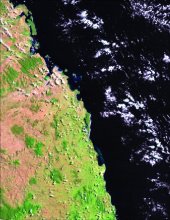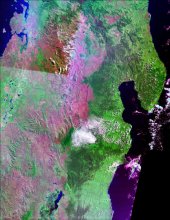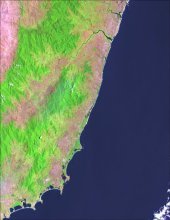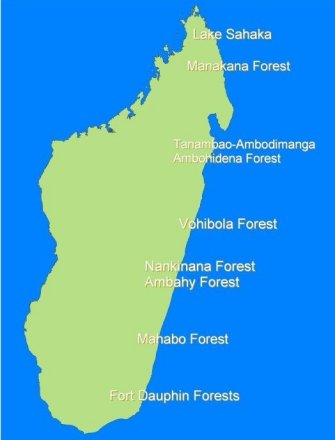 |
QUICK SEARCH
MO PROJECTS:
Africa
Asia/Pacific
Mesoamerica
North America
South America
General Taxonomy
Photo Essays
Training in Latin
America
MO RESEARCH:
Wm. L. Brown Center
Bryology
GIS
Graduate Studies
Research Experiences
for Undergraduates
Imaging Lab
Library
MBG Press
Publications
Climate Change
Catalog Fossil Plants
MO DATABASES:
W³MOST
Image Index
Rare Books
Angiosperm
Phylogeny
Res Botanica
All Databases
INFORMATION:
What's New?
People at MO
Visitor's Guide
Herbarium
Jobs & Fellowships
Symposium
Research Links
Site Map
Search
|
Radio-metrically and geometrically corrected Landsat Thematic Mapper (TM) Level 1G images (GLCF) covering the study area (path/row 158/68 - 158/77) were used to identify areas of potential littoral forest along the entire eastern coast of Madagascar. Images were downloaded from the Global Land Cover Facility website http://glcfapp.umiacs.umd.edu:8080/esdi/index.jsp
We examined five images dated from 1999 - 2000 and classified all areas within 5 km of the coastline as forest or non-forest. Littoral forest in eastern Madagascar occurs on sandy soil close to the coastline, while forest further inland is more commonly characterized by laterite soils. ArcView Image Analyst was used to import, view, and analyze all Landsat and aerial photographs. Image bands 5, 4, and 3 were assigned red, green, and blue respectively. Using our techniques and the 30 m resolution of the Landsat images, it was not possible to distinguish primary from secondary forest. Images were compared to known littoral sites on Du Puy and Moat’s (1996) map of estimated primary vegetation in Madagascar, along with ground truth data and field knowledge of areas recently visited by two of the authors. The characteristics of these areas were then used to identify other spectrally similar areas, resulting in six sites of priority for aerial photography and fieldwork.
|
© 1995-2025 Missouri Botanical Garden, All Rights Reserved
4344 Shaw Blvd.
St. Louis, MO 63110
(314) 577-5100
Technical Support



